We've written about murals on city buildings before, but why stop there? Why don't up the scale and the"wow" factor and turn an ancient castle into a fairy tale canvas? With no limits set to creativity, the results might end up to be as provoking as some Banksy street art masterpieces...
Of course, you'll have to find the abandoned castle first, and such real estate might be in short supply. In this case, the owners themselves commisioned a group of artists to spice up their humble abode... and they came up with -
...Bright Colors!


(image credit: Ben Cooper)
This is the Kelburn Castle in Scotland, close to a wonderfully-named Fairie village (Fairlie, actually) - see here - painted over by Brazillian street artists from Sao Paolo Nina and Nunca Os Gemeos (completed in June 2007):

(image credit: Agnes Frame)
This being a pretty romantic concept, "Painted Castles" end up in gothic romances and other inspiring fiction (see the book cover on the left, for example) - so the stately Kelburn castle (on the right) prepares to get the unusual art treatment:

The plans are made (not on the computer, it seems, but the good-old way):

And the final surreal product simply boggles the mind:

(image credit: Tim Kirman)
As you can see, Brazillian graffiti tradition is very vibrant, color-rich and transient / energetic. Taken out of its urban context, it illuminates the Scottish countryside with bold colors and shines through any rain-soaked misery the world can throw at it...

"Kelburn is thought to be the oldest castle in Scotland to have been continuously inhabited by the same family. The original Norman Keep, designed for defence rather than comfort, was probably built by 1200. The original Keep is now enclosed within a grander castle, completed in 1581." (source)



The street art coolness extends to the roof and chimneys:

(image via)
Here is the time-lapse video of how this castle got painted:
Link
You think this idea is unique and bright colors (some say "thankfully") are confined only to this particular castle in Scotland? Think again, or rather look at this castle in Sintra, Portugal -

(images via)
Often considered the first expression of romanticism in castle architecture, this Palácio da Pena was built in 1839 on a steep hill (see how it almost floats in the clouds); Moorish, Gothic and Romantic influences can be traced in its highly fanciful shapes and colors:


(bottom right photo by Zita Kamugira)
Rather more modern example of a colorful castle in Dublin:

(image credit: Victor)
and in the Czech Republic, the Cesky Krumlov castle is full of colorful spires and unbridled architectural imagination:

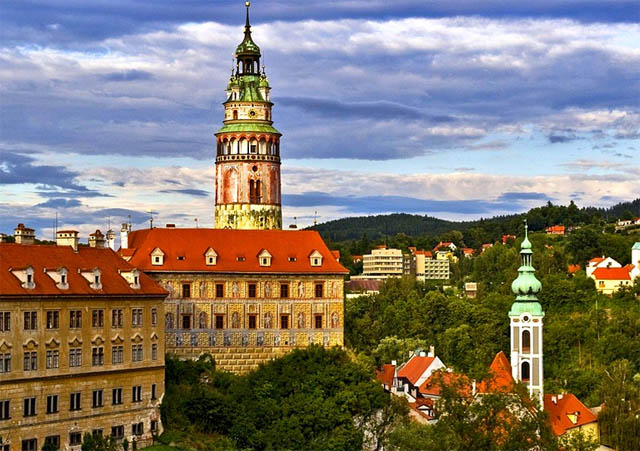
(images credit: Omid Tavallai, Nathan Bergeron)
Proper lighting inside the castle can always bring out additional creepiness, or sophisticated artistry of the decor and various set pieces:

(image credit: Robert)
Sun-painted castle
Sometimes nature conspires to show us that some of the most spectacular things are still, well, natural. No painter's hand touched the castle in the next picture (Wawel Castle in Krakow, Poland), and yet the ancient walls are immersed in golden glory of a sunset, the color applied in a smooth, sublime way - but only for a few fleeting minutes...
 A Man’s Home: Unusual Castles …and One Very Special Village
A Man’s Home: Unusual Castles …and One Very Special VillageArguably born the day that villagers -- and the people who profited off them -- decided that wood wasn’t strong enough to keep them safe, castles quickly became more than just edifices dedicated to security. Instead of repelling borders, real or imaginary, castles became THE status symbol of status symbols. Monuments to bravado, they were stone and mortal proclamations to the age-old idea that "mine is bigger than yours."
Pierrefonds - picture-postcard example of a castle
If you want an picture-postcard example of a castle, you don’t have to go anywhere but the Château de Pierrefonds in France. Although it may have started out as a structure designed to keep some folks out and others safely in, it was later partially sugar frosted by none other than Napoleon the 3rd, who was shooting for a true nobility status symbol: a iced cake that no one but the very rich and very privileged could eat.

(image credit: Frédéric Lavaux)
Pierrefonds is still a beautiful place, even if its fortifications were overly gilded –- or maybe because of it. It’s no wonder it's used to this day when central casting gets a call for a classic castle.
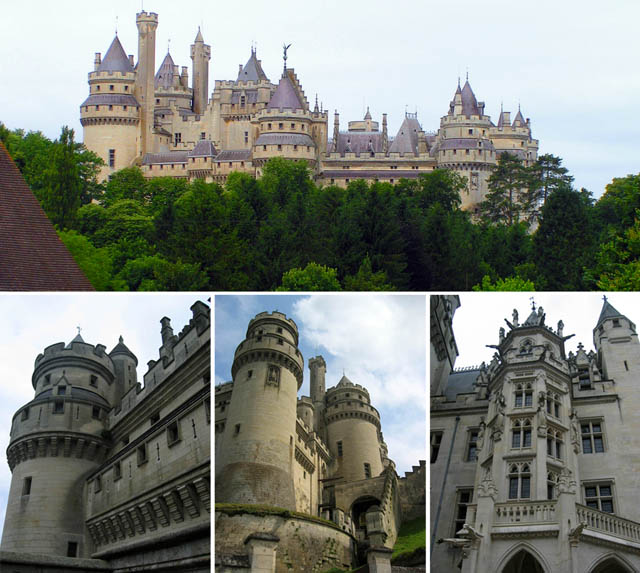
(photos by Ralph Gant and Benoit Stordeur, see more)
When fairy tale jumps from a landscape and hits you between the eyes
If you want a real Disney, fairy-tale, and totally insane castle, you have to visit the residence of one totally insane German king, namely Ludwig II of Bavaria. Look up gaudy in the dictionary and there’s a picture of his castle: Neuschwanstein ("The New Swan Rock").
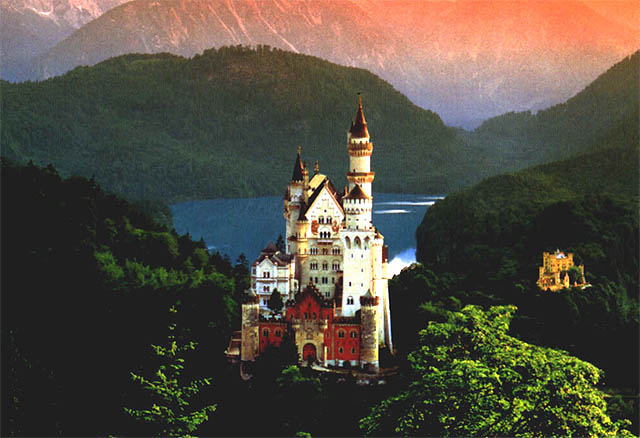

Neuschwanstein Castle, gracing ten million over-saturated postcards and jigsaw puzzles, (image credits unknown)
Glitzed and filigreed, Neuschwanstein is like Ludwig’s twisted brain turned inside out and realized in stone and brick. It is also sublime and splendid, over-the-top and strangely fragile - all at the same time. We are going to devote a special article to it, truly a place not of this world.

photos by Avi Abrams
Monstrous chandelier? Check. Room made to look like a cavern? It’s there. Entire rooms dedicated to Wagner (with whom Ludwig was obsessed)? Absolutely. It’s all there, larger and more ornate than any life … unless, of course, you were the King of Bavaria.

photos by Avi Abrams
The Coral Castle - Nobody knows how it was built
One of my favorite castles, though, wasn’t the dream of a king realized in stone and mortar. Spurned at the altar back in his native Latvia, Edward Leedskalnin took his disappointment, and a case of tuberculosis, to Florida in 1923. There, in the land of oranges and sunshine, Leedskalnin began to build his very own castle, one he worked on until his death in 1951 (more info)
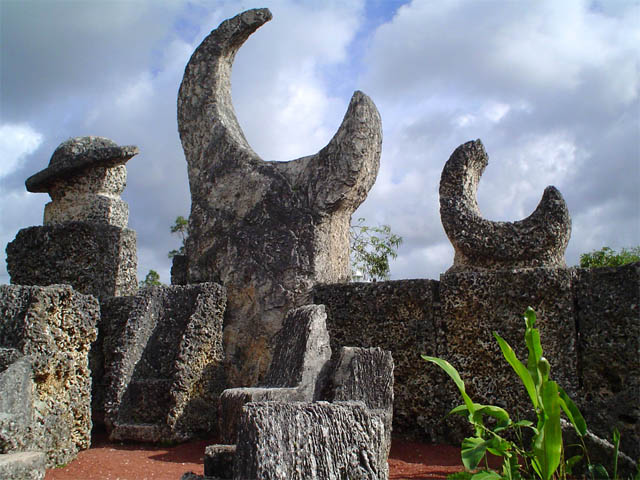
(image credit: sarahmizoo)

(images credit: Jim)
It’s still there and definitely worth seeing. It might not have the polish of Pierrefonds or the glimmer of Neuschwanstein, but Rock Gate Park, as he called it, is still a striking sight: monstrous slabs of coral skillfully balanced and beautifully positioned, all of them assembled without reinforcement or mortar. He spent over 28 years building the Coral Castle, refusing to allow anyone to view while he worked.

(The Throne Room, supposed to depict the Moon and the planets - photo by Claudia Domenig)
Leedskalnin’s construction genius is legendary. No one quite understands how he built his castle and then moved it ten miles away in 1936. Some people think he used a kind of perpetual motion machine or mystical methods to move his several-ton blocks. Whatever the means, his Coral Castle, is still a magnificent achievement -– the sublime result of his own two hands, his incredible inventiveness, and a tragically broken heart.
Portmeirion: a surreal village in Gwynedd, Wales
Stepping away from literal castles, but staying within the theme of very special men and the homes they created, one of the most beautiful is one you might not know the name of but one you’d recognize immediately. All I need to write is "You are Number 6."

(image credit: Richard Hagen)
Located in Wales, Portmeirion was created by Sir Clough Williams-Ellis in 1925 (though some of it wasn’t finished until 1975). Although Sir Williams-Ellis wasn’t a king, he was obviously knighted, and certainly had help with his remarkable residence. Portmeirion deserves to stand with Ludwig’s vision of Germanic paradise and Leedskalnin’s eccentric coral castle because of its unique, and spectacularly beautiful, vision.
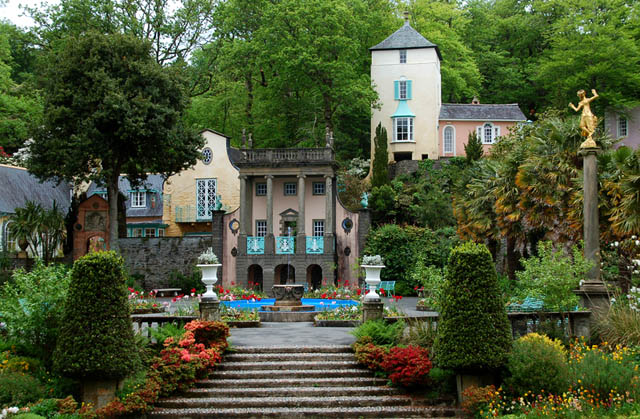
(image credit: Gavin D. J. Harper)
Williams-Ellis was so dedicated to preserving the tranquil elegance of Portmeirion that the filming location of Patrick McGoohan’s "The Prisoner" wasn’t revealed until the final episode of the series. Even with the careful hiding of the village’s identity, anyone who knew anything about architecture would have recognized the Williams-Ellis’s pearl-white cottages and the legendary green dome where, in "The Prisoner", the village’s rotating Number 2s had their office.

(image credit: Matt Buck)
Portmeirion is truly a beautiful place and completely unspoiled by its television appearance. It remains today just as Williams-Ellis intended it to be: a tranquil village with a tasteful dusting of nostalgia.
The Postman's Palace - another single-handedly built castle
Ferdinand Cheval has imagined his "Ideal Palace" and simply went on to built it - after all, why not? He spent 33 years with this project (located in the village of Hauterives in the picturesque Drôme region of Southern France) - but the results are nothing less than stunning:


(photos by Emmanuel Georges, Eric Devlies, Francerama)
Initially considered "the village idiot", he was suddenly hailed as a genius and a celebrity in France, upon completion of this intricate affair. But is it the "Ideal Palace"? Everyone seems to have a different opinion. More info and images are on this page.
Whether it's the gussied-up fortresses like Pierrefonds, the gilded dreams of a mad king like Neuschwanstein, the eccentric genius of Leedskalnin and his Coral Castle, or the whimsical grace of Williams-Ellis’s Portmeirion and Ferdinand Cheval's Palace, a man’s home can really be his castle.
More Fantastic Castles, to Visit and to Think About (Wistfully)
Eltz Castle, Germany: another fairy-tale location, this time completely surrounded (and in certain degree concealed) by the forest:
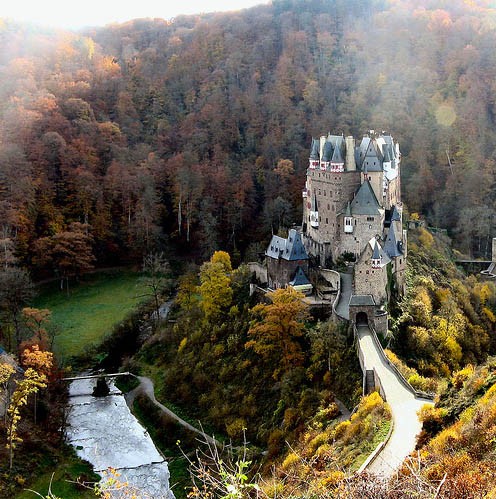
(image credit: frizztext, see more)
Germany (just like Switzerland and Austria) has many enchanting castles, big and small -

Castle-like mansion in Arnsberg and a large Buerresheim Castle, photos by frizztext
The stretch of Rhein between Cologne and Mainz has the especially high concentration of great fortresses, presiding over the quaint riverside villages:
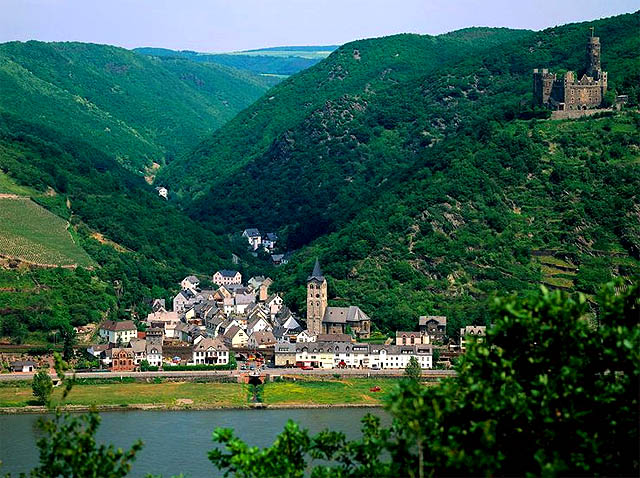
This is a great site listing all the castles
Egeskov Castle, Denmark:
(image credit: Malene Thyssen)
Eastern Europe abounds in awesome castles. This is for example, Castle in Moszna, Poland:

Check out the sinister door handle from the Dracula's Bran Castle on the bottom right. Towers emerging from the mist in the photo below: this is Bragança, a walled town in northern Portugal. Very evocative image on the bottom left is Le Chateau de Nyon in Nyon, Switzerland:

(originals unknown)
The Chittorgarh Fort in India. This pool was often the only source of water during the numerous sieges by Mughal Emperors:

(image via)
Nestled in High Places:
The way to the Guaita Fortress in San Marino (more info) -
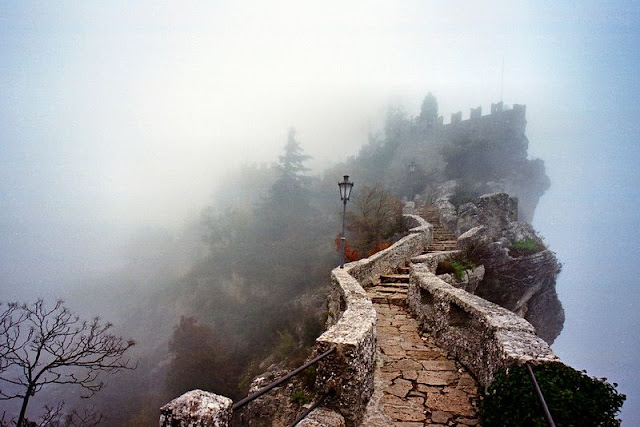
Try not to think of "Myst" and "Riven" while looking at the above picture... Here is the high cliff on which the fortress stands:

(image credit: Ricardo André Frantz)
Overlooking the Echaz Valley and the storybook village below, often shrouded in fog, Lichtenstein Castle comes close to being the perfect castle in Europe.

(image credit: Andreas Tille)
The Abandoned Castle in Rural Italy
Oh yes, still unclaimed by some luxury developer, nor touched by multi-million renovation... hiding in a valley in a tangled forest: Castello di Zena:
(here is a Google Earth location, but don't set your hopes too high - this is a guarded private property)

(image credit: cyberbiscottato)
A mystery. Falling to pieces. Splendor in the grass.
A View That Launched 10,000 Epic Fantasy Books
Another feature of fortified high places is the splendid view they often afford. We'd like to open up a sort of competition: The Best View From a Castle, but the winner already easily comes to mind - and it's the Neuschwanstein's Castle, again. The panorama of the towering Alps and a nestled gem of the lake, Alpsee, is enough to make you sigh and close your eyes... dreaming.

Photo by Avi Abrams
The ultimate castle, that was ever designed to grace the face of the Earth
King Ludwig, again. The planned Falkenstein - truly THE Lost Castle. The one that he was all set to build - but for the financial (and mental) meltdown he suffered.
 When Designers Go Around the Bend
When Designers Go Around the BendIn our previous article we've seen some mind-scorching and trance-inducing lamps, tables and chairs...
Now we continue in the same groove, bringing to you the wildest furniture ideas - and more temptation to dump your current boxy bedroom sets and go for their "Mad IKEA in the Wonderland" variety.
Wireframe Furniture by Thomas Raschke - for the obsessed 3-D artists who see wireframe behind everything anyway:

This is not some kind of unfinished rendering, but pretty solid welded iron carcasses. Some slim folks might fall through the holes in these chairs, and coffee cups are definitely not safe on top of this "mesh" table.
It would be hard to get into this chair (but for entirely different reason) -

(design by Vladimir Tzesler and Sergei Voichenko)
Just as impractical (and vastly more uncomfortable) is a bristling Bed of Hay:
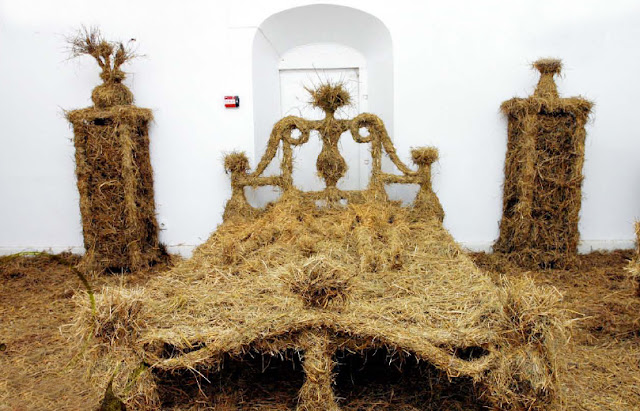
(photo by Arthur Klimov)
You would need a matching lamp to illuminate your ceaseless activity in this bedroom (since the itch and prickle will surely keep you awake all night).
"Antler Lamp" by Frank Buchwald will do just fine, but don't place it close to the hay -

Similarly-styled "branch" bookshelf (more info)

We do hope you enjoy spending time carefully balancing heavy objects. Don't put this one too close to your bed, either.
If you're not very squeamish, you can find "Armadillo Shell Lamp" in an antique store (with some luck) -

(image credit: Modern Mechanix)
For more tech- and steampunk-oriented individuals Frank Buchwald offers special series of lamps:

(image credit: Frank Buchwald)
If you're more into the surreal and like to pretend your life is a Dali painting, here are just the shelves for you:
(more info)
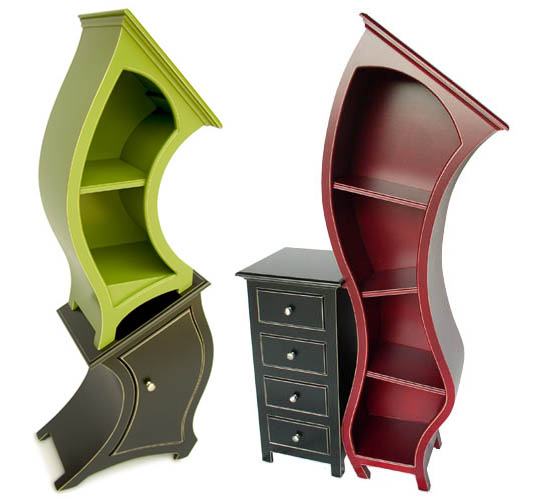
(image credit: Dust Furniture)
While on the topic of unusual shelving, if you ever feel that you just want to disappear into a library, these shelves will help you do just that - and perhaps they make it easier to get the books on the upper shelves?

(images credit: Offbeat Homes and Ron Arad)
On the right is another variation on the theme of "curved bookshelves" (more info)
Or if you're more into geometric designs the Opus shelving system will work better:

Addictive Modular Shelving
We know that you have many pressing things to do with your time, and we're here to help you procrastinate as long as possible. We suggest you purchase pieces of this set and spend your time arranging... rearranging...
First one is from Tetrad Shelving:

Or you can have Cube Shelving by Andrew Tye (info) or Doris Kisskalt's Modular FlexiTubes (info) -

You can even have tetris-shaped bricks to help you build your ultimate tetris-shaped house:

(image credit: LevelSelect)
A Place of Solitude
Find yourself in a place that at once says "I'm a total geek" and "don't come too close"! Wait... isn't the second implied anyway?

This is a "Sonic Chair", by a German firm Designatics - creators of the egg bed and egg-like chair below:

Wallpaper for those who don't do drugs:
...those who do, will see all walls like that anyway.
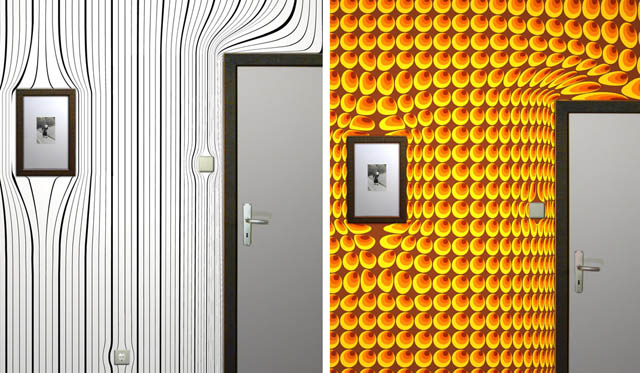
Warping Wallpaper from Surrealien... A visual representation of an object's effect on the gravitational matrix of the universe, yes sir.
Entering the hall, looking (with a suppressed shriek) into a Meat Mirror (more info) -

(design by Victoria Reynolds)
Staggering into the bathroom... observing some potty-trained fish!.. This is a Fish'N'Flush toilet:

The supply of fish will need to be replaced after each flushing (just kidding).
Furniture not for "squares" or "blokes" of any kind
Be creative. Think (and sit) different.
Bike Chair from Bike Furniture is made from bikes, wouldn't you know:

Mother in Law coming for a "short" visit? If you lack the "leave me alone pod" to keep her out of your hair, you can always bring out the Cactus couch:

And if that doesn't deter her, perhaps realizing your coffee table isn't housebroken (and the other table clearly drunk) will do the trick:

(image credit: Straight Line Designs)
By the way, the best way to keep unwanted guests out is simply replace your doors with these:
 The Leaning Skyscraper has Graceful, Wavy Curves
The Leaning Skyscraper has Graceful, Wavy CurvesIt seems, that architecture in Dubai (see our previous update) sprouts every possible shape and form known to man - plus reaches to the lofty heights in new and proposed high-rises - but this one is probably the strangest of them all:
The Wave Tower, Dubai
A-Cero (Joaquin Torres Architects) firm in Madrid, Spain, has designed and proposed a high-rise tower for the Dubai waterfront. The project has been already mentioned in specialized press, but we think the design is particular and sexy enough to captivate anyone who is slightly interested in architecture.
The first skyscraper for the Dubai Waterfront, the latest and biggest of the urban developments on the UAE coast, has been named The Wave Tower.
"It stands like a stylized stem with a light torsion, creating the elegant movement that characterizes the form of the shape of the building. The base has the form of a pointed arch with smooth bends, imitating the waves in the Gulf Sea.
The structure is solved with "V" form unions between the different parts in the plan view, its center space is occupied central core by the installations and elevators. Interior sky gardens are present in all the common zones, distributed on different floors, improving the air quality and working as natural temperature regulators."
Location: Madinat Al Arab District, a zone under development that is expected to become the new downtown and central business district of Dubai.
Height: 92 floors, 370 meters
Materials: Double skin facade made of silk screened glass for solar control.
Uses: Mixed use (commercial, offices and high end residential).
The same architectural firm A-Cero created very imposing street-level GIBO project in Madrid:
(images credit: A-Cero)
Pentominium - to the clouds and beyond
Looks like the previous project will nicely complement already almost finished Pentominium by Trident International Holdings in Dubai. Just look at the view on artificial island archipelagos - from a swimming pool, or open bar:
(images credit: Trident International Holdings)
This is officially the highest condominium tower in the world.
Ecological Tower in Siberia
Foster & Partners revealed designs for the ecological tower in Siberia, Khanty Mansiysk: an elegant crystalline form, which blends well with the epic Siberian landscapes.
"280m tall tower is faceted like a cut diamond, designed to maximize daylight through the winter months, reflecting and refracting natural light to illuminate the interior spaces." (more info)
Crystal Island, Moscow Russia
Same company Foster & Partners is proposing a mixed-use unique structure 450m high only 7.5 km from the Kremlin: "The building’s form spirals upwards in converse directions to form a diagonal grid, and the spiraling geometry extends throughout the project into the park."
Two Disc Skyscrapers for Baku
South Korean Heerim Architects firm has proposed two towers for Baku, capital of Azerbaijan and the largest port on the Caspian Sea. "Full Moon Hotel" will symbolize the full moon of its name, and will be located across the bay from "The Crescent Hotel" (height: 158m, 32 floors) -
(more info & images here)
Over in Germany: Fantastic Ball Shape
European Central Bank in Frankfurt will have a somewhat recognizable shape of a coin, designed by United Architects. This proposal might turn out to be too radical for the tastes of highly conservative bank, but it's still spectacular competition entry: (more info)
Even Stranger Shape: Euroscraper
Euroscraper (by Munoz Villers) has a strangely looping form, which apparently reduces resistance to wind, and provides better light for green spaces inside. Again, this is only award-winning entry in the competition, but we are rooting for it mightily, wishing such fantastic (and audacious) structure might some day be built. (More info)
The following buildings and structures can not be called skyscrapers, but we get excited to see them in concept stage, a testament to current abundance of creativity in modern architecture:
The Scala Library, Copenhagen
Another proposed European project: a "Turning" Tower in Copenhagen, designed by BIG. The tower's shape will integrate well with other prominent spires and cathedrals of the Old City. (More info)
Highly Individual "Portrait" Architecture
Airport Hotel & Conference Center for Stockholm, Sweden, designed by the same company BIG, looks like a portrait, or face engraving, floating over the forest.
Apparently the lighting of various "faces" is dynamic, and can be changed almost on a whim:
Very cool apartment building complex is proposed by the same company for Kiev, Ukraine:
This deeply philosophical statement out of the way, allow me to introduce you to the most fascinating and soaring examples in bridge architecture - the structures that can be considered a destination in themselves, not just a means to get from point A to point B. (Read the first part here)

(image credit: H. P. Kolb)
1. Historic "La Pont Du Gard" Bridge
The name literally means "Bridge across the river", which only serves to prove that this is THE bridge among all bridges. Built sometime around 20 B.C. by the Roman Empire in the South of France, this is one of the most ancient, and possibly the most beautiful of all Roman-built aqueducts. Pont du Gard crosses the Gardon Valley and reaches 49 meters in height, measuring 280 meters in length.
Every huge block of stone (some of which weigh up to 6 tones) was carved to perfectly fit in its place, making this grandiose structure a marvel of masonry & engineering. A number of writers celebrated this bridge in their works, including Jean-Jacques Rousseau in "Confessions". Numerous inscriptions, some ancient Roman in origin, cover the stones, making the whole site a historian's and photographer's paradise.
(images credit: candi)
From the most ancient, to the most futuristic -
2. Soaring Bridges of Santiago Calatrava
Santiago Calatrava is one the most sought-after bridge architects today. His works are dynamic, reflecting our modern age. They also possess the uplifting harmony of sweeping curves and intricate shapes. His Sundial Bridge at Turtle Bay is an interestingly shaped, somewhat futuristic bridge (which doubles as a sun-dial). It was recently built near Redding, California.

(images credit: turtlebay.org)

Alamillo Bridge in Seville, Spain, photo by Andrew Dunn
Calatrava also applied his soaring, spread-wings style to the footbridge at Milwaukee Art Museum:

(images credit: Jim Brozek)
Although nothing really comes close to the City of Arts and Sciences that he designed for Valencia, Spain - the culmination of his highly elegant style.
Salvador del Saz has an awesome set of photographs of the building and the bridge leading to it:



(images credit: Salvador del Saz)
3. Double Spiral Bridge in Japan
The Kawazu-Nanadaru Loop Bridge consists of two spirals, each 1.1 km long, 80-meter in diameter - the only way for traffic to get down the mountainside into the valley, too steep for any other usual road-building solutions.
The busy Route 414 serves the weekend crowd from Tokyo, intent to wind down at the hot springs resort of the Izu Peninsula. The "winding down" bit obviously starts at this bridge. Built in 1981, the double-spiral structure demands careful driving - the speed limit on the bridge is only 30 km/h, which also helps to better enjoy the views.


(image credit: whatjamiefound)

(image credit: Toshiaki Iwahori)

(image credit: Altus)
4. Nanpu Bridge with a spiral approach
Similar spiral skyway graces the approach to the Nanpu Bridge over the Huangpu River, located at the South Dock in Shanghai, China. Drivers are allowed to go only clockwise... no, just kidding.

(originals unknown)
The longest bridge in the world is officially Lake Pontchartrain Causeway in Louisiana, which is essentially just a stretch of highway. The following structure is a bit more interesting:
5. The Longest Bridge-Tunnel Combination: Oresund Bridge
This longest combined road and rail bridge in Europe connects Denmark and Sweden across the Oresund strait. The artificial island itself is 4 km long. Shortly after being built, there were fears that not enough people are going to use it, but as it turned out, Danes were buying less expensive houses in Sweden and commuting to work in Denmark, and the construction costs of close to 30.1 billion are expected to be paid off in 2035.
Also a bridge-tunnel combo, but smaller, is Merrimack/Monitor Memorial Bridge-Tunnel on Hampton-Chesapeake Interstate 664:
(image credit: roadstothefuture)
6. The Bosphorus Bridge - connecting 2 continents
This grand-looking bridge spans the Bosphorus Strait in Istanbul, Turkey. Interestingly, it also has a twin: a similar bridge located just down the Strait.
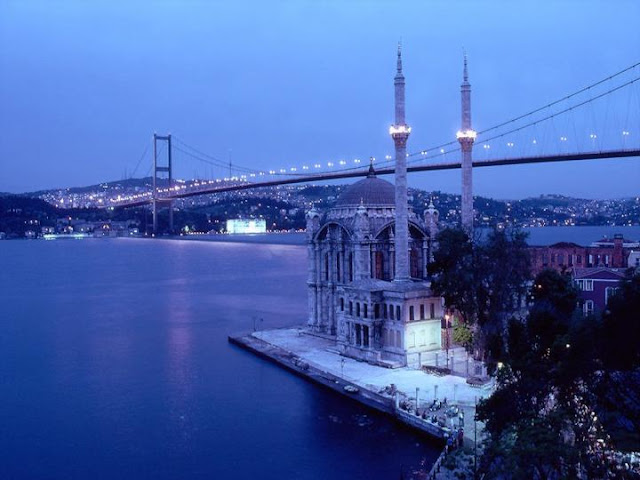
(original unknown)
7. The Hanging Bridge of Bilbao, Spain
Built in 19th century, in a year of 1893, it introduced truly revolutionary combination of 150-meter long steel bridge and a hanging gondola, moving across the river. Similar structures were built after its example, but only a few remain in existence today in the world. The 43-meter towers present an imposing view over the city:
Another interesting bridge concept: a footbridge with counter-balancing weights:
(image credit: Kiel Bryant)
The "bridge-to-nowhere" illusion, seen in Norway:


(image via)
A few other interesting (and beautiful) bridges:
Stonebridge in Regensburg, Germany:

(image credit: Luca Ivaldi)
Freedom Bridge, Budapest, Hungary:

JK bridge across Paranoa Lake, in Brazil:
Newport Pell Bridge, Newport, Rhode Island:

(original unknown)
Conwy Suspension Bridge in the medieval town of Conwy, North Wales:
The Tsing Ma Bridge, Hong Kong:
Strange bridge in Victoria, Canada: Johnson Street Bridge.
(image via)
Spiral bridge-link between two buildings, over Floral Street in London:
And our traditional mystery bridge:

UPDATE: Colsh says: "The mystery bridge is the Skye bridge connecting the Isle of Skye to mainland Scotland. I believe at one time the most expensive toll bridge in the world (per kilometer)."
Futuristic Arctic Bridge

Underwater tubular super-structure, imagined in Russia way back in the 50s and described by Alexander Kazantzev in his sf novel.
Harrowing Hanging Bridges
For the most amount of thrills you can get for free in this world, try to drive across some of the following structures, if not on your car, then on your bike. This is what many locals often have to do, in absence of any other ways to get across.
Historic Hagwilget Bridge in British Columbia, Canada
The first foot bridge looked positively frightening:

(photo courtesy BC Archives Collection)
The second bridge across the river had quite an interesting engineering approach:
(image from 1916 book "Bridge Engineering" by H.G. Tyrrell)
(image credit: Eric Sakowski)
The second and third bridges are visible in this photo. It is also possible that both were true road bridges - imagine driving your car across that!

(photo courtesy BC Archives Collection)
Vjose River Bridge Experience
Some of the hanging bridges can be quite daunting not only to set your feet on, but even to look at. Roberto Ferri sent us these pictures, taken in Southern Albania, ten miles north from the Greek border. Both bridges shown here require a bit of work and a prayer to get across:

(images credit: Roberto Ferri)
Crossing the Hussaini Bridge in Pakistan. The mountains in the background are called the Passu Cathedral:

(Photo by Herbert Wong)
Finally, feast your eyes (and nerves) on -
The Worst Bridge in the World
The bridges we chose for this page may not be the most obvious candidates for the World's Most Amazing Bridges, like San Francisco's Golden Gate bridge, Rialto bridge in Venice, Vancouver's Lion's Gate bridge, or Millau bridge in France. This is, however, an interesting list, which also promises to be a start of a new series

Rialto Bridge in Venice, photo by Avi Abrams
The history of bridges would be a boring one, if I was to lay it out for you. I can imagine the story going something like this;
"It was the year 3308. Of course, they didn’t call it that back then, it was just "3 years after our Ahab was born!" A village had realized that, the grass was indeed greener on the other side. However the other side in this case just happened to be split by a river. They were baffled; "How can we get over there?" one asked. Weeks of thought later and finally a young man who had decided to leave his elders to their thoughts went down to the lake to test out a theory. Taking his axe with him he felled a tree, and let it fall directly across the river. He walked across, and back again, firm in the knowledge that his village’s future was secure."

Two bridges in the Golden Gate Park, San Francisco, photos via 1, 2
It’s not the world’s most thrilling tale of beginnings, nothing like what I’m sure the tale belonging to the theft of fire would be like. But since I’ve been able to successfully entertain you safely past the beginning of this article, I will endeavor to hold your attention by showing you through some of the most interesting bridges that have come across my monitor. And no, they won’t all be the heights of technological engineering, but simply those that have captured the imagination in various ways throughout time.

San Francisco's Golden Gate bridge, photo by Don & Elaine
"Stari Most" (Old Bridge) - Fascinating History
The first bridge on my list is a biased choice, and may not have originally made anyone else’s list of favored bridges. However with my mother a missionary in the area of Mostar, Bosnia, I had to pick this bridge for its meaning to me. However the bridge itself has a whole host of its own history.


Destroyed by Herzegovinian Croat Catholic militia during the War in Bosnia-Herzegovina, on November 9, 1993 at 10.15 am, the bridge spans the Neretva River in the old town of Mostar. Stari Most thus provided the fourth largest city in the country with its name.

Star Most is a hump—backed bridge, 4 meters in width and 30 in length, and towers above the river at a height of 24 meters at its highest point. The Helebija tower on the northeast and the Tara tower on the southwest are known as the mostari, or "the bridge keepers".

Stari Most was commissioned by Suleiman the Magnificent in 1557 to replace an older wooden suspension bridge. Construction began in 1557 and took nine years to complete and, according to the inscription the bridge, was completed in 974 AH, which corresponds to the period between July 19, 1566 and July 7, 1567.

And, if you’re interested, the bridge often entertains young men willing to dive in to the chilly water below. An interesting native practice that dates back to the origin of the bridge itself.
Getting ready to dive:

Still alive!

(images credit: Joy Hill)
Gateshead Millennium Bridge
Spanning the River Tyne in England between Gateshead on the south bank and Newcastle-upon-Tyne on the north, the next bridge in our journey was another of the projects commissioned for the turn of the Millennium. It is a pedestrian and cycle bridge, instead of a stereotypical automobile bridge, and its design provided designers Wilkinson Eyre (a high-profile architecture firm) with the 2002 Royal Institute of British Architects (RIBA) Stirling Prize.


(images credit: Fr.structurae.de)
What’s special about this bridge is its ability to allow boats and other water traffic to move underneath it, despite being relatively low to the surface of the river. Mini hydraulic rams on each side of the bridge tilt it back on special pivots, lifting the bridge out of the way of those attempting to go underneath. This move has lent the bridge a new nickname, the Blinking Eye Bridge.

This is how this bridge was put in place: manufactured a few miles down the river and transported upriver by the "Asian Hercules" (Rotterdam) floating crane:


(images credit: Longsands)
This is the only bridge that "loves you" back :)

The Longest Arch Bridge - Lupu Bridge
The Lupu Bridge is currently the longest arch bridge in the world, stretching a massive 550 meters across the Huangpu River, China. Along with being a record holder ("The bridge's arch is longer than the previous record holder, the 518-metre long New River Gorge Bridge in West Virginia"), the bridge is also the center point for a lot of local hostility.


(images credit: cssc.net.cn)
The need for a bridging between the Luwan District on the north bank, and Pudong New District on the south bank was agreed by all, but that was where the agreement stopped. The exorbitant cost of the Lupu Bridge was frowned upon by locals and scholars, but chosen by the disgraced mayor Chen Liangyu as it would set the area apart with a world record bridge. The critics use this bridge as an argument to prove the city officials superficiality, when weighed against the needs of its people.
Construction of the Lupu Bridge:


(image credit: Leica Geosystems)
Another shot of Chinese breathtaking bridge construction: this time showing suspension bridge over Jiangyin Yangtze River - cable construction with preformed parallel wire strands (PPWS) technique:

(images credit: ChinaPage)
Hangzhou Bay Bridge, China
This bridge, recently completed, is the world’s longest trans-oceanic bridge, stretching across Hangzhou Bay off the eastern coast of China. Connecting the municipalities of Shanghai and Ningbo in Zhejiang province, it was linked at 3pm on June the 14th, 2007.

Measuring in at 36 kilometers long, and with six expressway lanes makes it the second longest bridge in the world, with only the Lake Pontchartrain Causeway in Louisiana, USA beating it out.

Another of the bridges that seem to be a wasteful choice of bridge, it seems as though the Chinese government are making great architectural decisions, but are failing to consider what their people actually want. Nevertheless, designed to last 100 years, the Hangzhou Bay Bridge will be open to the public some time in 2008.
Great Belt Fixed Link
The last on my list of bridges, this bridge is the fixed link between the Danish islands of Zealand and Funen across the Great Belt. It consists of a suspension bridge that makes up the road on top, as well as a box girder bridge between Sprogø and Funen. Between Zealand and the islet Sprogø there is also a railway tunnel that runs beneath the road.

(image via)
Made up of two bridges the Eastern suspension bridge is 6,790 metres (22,277 ft) long with a free span of 1,624 metres (5,328 ft), making it the world’s second largest suspension bridge. The Western box girder bridge is 6,611 metres (21,690 ft) long, and has a vertical clearance for ships of 18 metres (59 ft). The Western Bridge is essentially two bridges though, with the rail component making up one bridge, and the road component the other. The only factor keeping them as “one” is the fact that their foundations are the same below the sea level.

More fun with bridges:
Fascinating Abandoned (Ruined) Bridge
Kinzua Viaduct in McKean County, Pennsylvania:


(images credit: venangoil)
Once the world's highest and longest rail viaduct bridge (the center towers were about 300 feet tall when standing) was toppled by extremely strong winds - a possible tornado - in 2003... The ruins tell the story: (see more pics here)

Also read up on the history of this once-imposing structure here
Bridges as Art
Check out this is absolutely absurd, creative installation in the heart of Russia: "The Half-Bridge of Hope" - more pictures and info here.



(images via)
"The Most Unusual Photograph of a Bridge Award"
This honor goes to Carl Madson, for this angle of Golden Gate bridge:

(image credit: Carl Madson)
Mystery Bridge
See if you can identify this structure:
 Most ecologically friendly house designs
Most ecologically friendly house designsThis article is co-written by our guest blogger Joshua S. Hill, from My Writing Voice and Avi Abrams, Dark Roasted Blend. We continue the "ecologically clean living" theme, started in the previous post "Alternative Energy Mega Projects". Today we address projects on a much smaller scale - like designing a house
"A Low Impact Woodland Home" by Simon Dale
Now I had originally intended to take you on a tour through all the wonderful ecologically-clean houses that exist in our wonderful world, but it turns out that as a group, those who tend towards these houses apparently disdain the creation of a decent website, and even further hate actual content. So I am grateful for Simon Dale, the man behind "A Low Impact Woodland Home", who's provided me with great photos, and has a fantastic website.


 Simon, with his wife, father in law and two young children spent 4 months building what they have termed a low impact woodland home, which is now their family home. An estimated 1000-1500 man hours and £3000 were put in to what is, in my opinion, a dream home.
Simon, with his wife, father in law and two young children spent 4 months building what they have termed a low impact woodland home, which is now their family home. An estimated 1000-1500 man hours and £3000 were put in to what is, in my opinion, a dream home.

Simon, who is more than willing to tote the fact that he is in no way an architect or certified builder, believes that a house of this scale is within the reach of any able-bodied person.

The house, which was built with a maximum regard for the environment around it, is dug soundly into the hill around it. The idea of earth sheltering for housing is not a new idea either, and is more than just a "nifty hippie" way to help the environment; it also helps your bank account. When built into the ground, such a house will retain heat in the winter, and be very cool in the summer.

The dirt from the diggings into the hill provided the basis for the foundations and retaining walls, and a mud and turf, when combined with a plastic sheet, makes for the perfect roof.

Wood from the surrounding woodland provides not only heat but also wood for the frame of the house.

Seeing the houses like these gives me hope that - given the right amount of money - I’ll soon be living in my very own ecologically friendly home. Just as long as I have my computer, a light for my reading, and the internet, I should be happy.
Other nature-friendly designs around the world
An interesting Asian take on eco-friendly house design is the "Tree House" (though neighbors call it "Crazy House") - owned by the daughter of the ex-president of Vietnam:

See more photos here
For the ultimate in style (and $$$), plus unbeatable location, try Pierre Cardin's "Bubble House" (designed by Antti Lovag) in Cannes:

(images credit: Ken Sparks)
Roger Dean's House
Roger Dean is a famous fantasy artist. No wonder his house looks like something straight out of the fantasy realm:

The gently-flowing shapes of the interior are very inviting and soothing to the eye:

(images credit: Roger Dean)
"Spirit Sphere" Tree-Houses, Vancouver Island Rainforest
This is an absolutely marvelous idea: a bare minimum of living space, surrounded by the grand majesty of the forest - a 9 foot sphere with a comfortable bed, kitchen and most modern amenities, including high-speed internet connection. "Living like Ewoks" turns out to be quite popular among many refugees from urban stress and corporate culture, who purchase these pre-manufactured homes from Tom Chudleigh, the owner of "Free Spirit Spheres". The small company lists their address in Qualicum, Vancouver island, but then they add that they recently moved somewhere into the forest... "new location is out of cell phone range. The trees are better though."









(images credit: Tom Chudleigh, used by permission)
More info at this site
For the ultimate thrill (but definitely not peaceful nature existence) try living in this tree-house :)

No comments:
Post a Comment